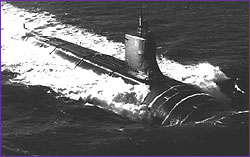
|

|
400 Years of Subs Introduction | 1580-1861 | 1861-1900 |1900-1918 1918-1939 | 1939-1945 | 1945-1972 | 1972-2000 1972 Development was underway on the next-generation submarine-launched ballistic missile, Trident, C-4, which had twice the range of the C-3. A C-4-equipped submarine could launch at the most logical targets in the Cold War world while sitting in New York harbor. The U.S. would no longer need to maintain overseas submarine bases in Scotland, Spain, and Guam, and the Navy closed those bases when the C-4 became operational. The C-4 missile first flew in January 1977.
1974 The U.S. Central Intelligence Agency attempted to raise a Soviet Golf-class diesel-powered boat, K-129, which sank in 1968. The agency did so under cover of a deep-ocean mineral recovery effort using a ship built for the purpose, the Glomar Explorer. The submarine apparently broke apart and the stern half fell back to the bottom. 1982 During the Falklands War, two British ASW carriers, more than a dozen other surface warships, five submarines (four of them nuclear), and even patrolling aircraft became occupied at certain times in protecting the force against two badly maintained, poorly manned Argentine submarines. One was a post-World War II Guppy and the other an eight-year-old German boat that, in the end, had nil effect upon the war. Be not deceived by this comic-opera vignette, however. For the British, the submarine war was deadly serious. With two World War II-vintage torpedoes, the British submarine Conqueror sank the World War II-era Argentine cruiser Belgrano (ex-USS Phoenix), killing 368 sailors. 1982 Planning began for the next-generation American attack submarine: another Seawolf, SSN-21. The Navy adjusted the hull number (the next in the series would have been 774) to celebrate Seawolf as the "submarine of the 21st Century." It features the most sophisticated systems imaginable. Size: 353 feet long, 40-foot diameter, 8,000 tons. Top speed: probably in excess of 35 knots. According to one program manager, when underway at quiet speed, Seawolf would be as quiet as a Los Angeles boat sitting at the pier. Quiet speed may be in excess of 20 knots. 1986 On October 6, a Soviet Yankee-Class nuclear-powered missile boat, K-291, sank in the Atlantic 680 miles northeast of Bermuda, from an explosion in a missile tube. 1989 Soviet submarine Komsomolets sank in the Norwegian Sea. Most of the crew abandoned ship, but while waiting for rescue in the frigid waters, 34 of them died from hypothermia, heart failure, or drowning. This accident prompted the Russians to develop individual escape survival suits rated to a depth of 328 feet, and led the U.S. Navy to adopt the Mark 10 British-designed Submarine Escape Immersion Module. This provides individual full-body thermal protection and has been tested to 600 feet.
Seawolf joins the fleet. 1997 In preparation for development of the next submarine class (Virginia), the U.S. Navy elected to create a one-fourth-scale, unmanned submarine to test new and emerging technologies before they are committed to full-scale ships. Designated the Large Scale Vehicle (LSV) 2 and named after a species of trout, Cutthroat, the 111-foot boat is scheduled for delivery to the Navy in the spring of 2001. 2000 The U.S. Navy is testing Avenger, a 65-foot mini-submarine with a closed-cycle engine powered by diesel fuel and liquid oxygen. Intended for use by SEALs, the Navy's clandestine amphibious assault teams, Avenger can carry 18 troops and a crew of six. 2000 The Russian missile attack submarine Kursk, K-141 sank while on maneuvers in the Barents Sea. Placed in service in 1995, the 510-foot Oscar II-class Kursk had a surface displacement of 14,700 tons and speed in excess of 30 knots. On August 12, the sound of at least two explosions reached the Norwegian Seismic Service and five other ships operating in the area, including two American and one British submarine shadowing the exercises. The cause of the accident remains unknown, although Kursk had radioed for permission to launch an exercise torpedo about an hour and a half earlier.
2000 In this year of the 'official' 100th anniversary of the submarine (dating from the U.S. Navy purchase of the Holland in 1900), some 47 nations operate more than 700 submarines, almost 300 of them nuclear-powered. A host of countries, including the United States, Germany, Italy, Denmark, Norway, Sweden, and Japan, are pursuing new designs. In short, the submarine appears to be in the best of international health. Tour U-869 | Sole Survivor | Hazards of Diving Deep 400 Years of Subs | Map of Lost U-Boats | Fire a Torpedo Resources | Transcript | Site Map | Hitler's Lost Sub Home Editor's Picks | Previous Sites | Join Us/E-mail | TV/Web Schedule About NOVA | Teachers | Site Map | Shop | Jobs | Search | To print PBS Online | NOVA Online | WGBH © | Updated November 2000 |


